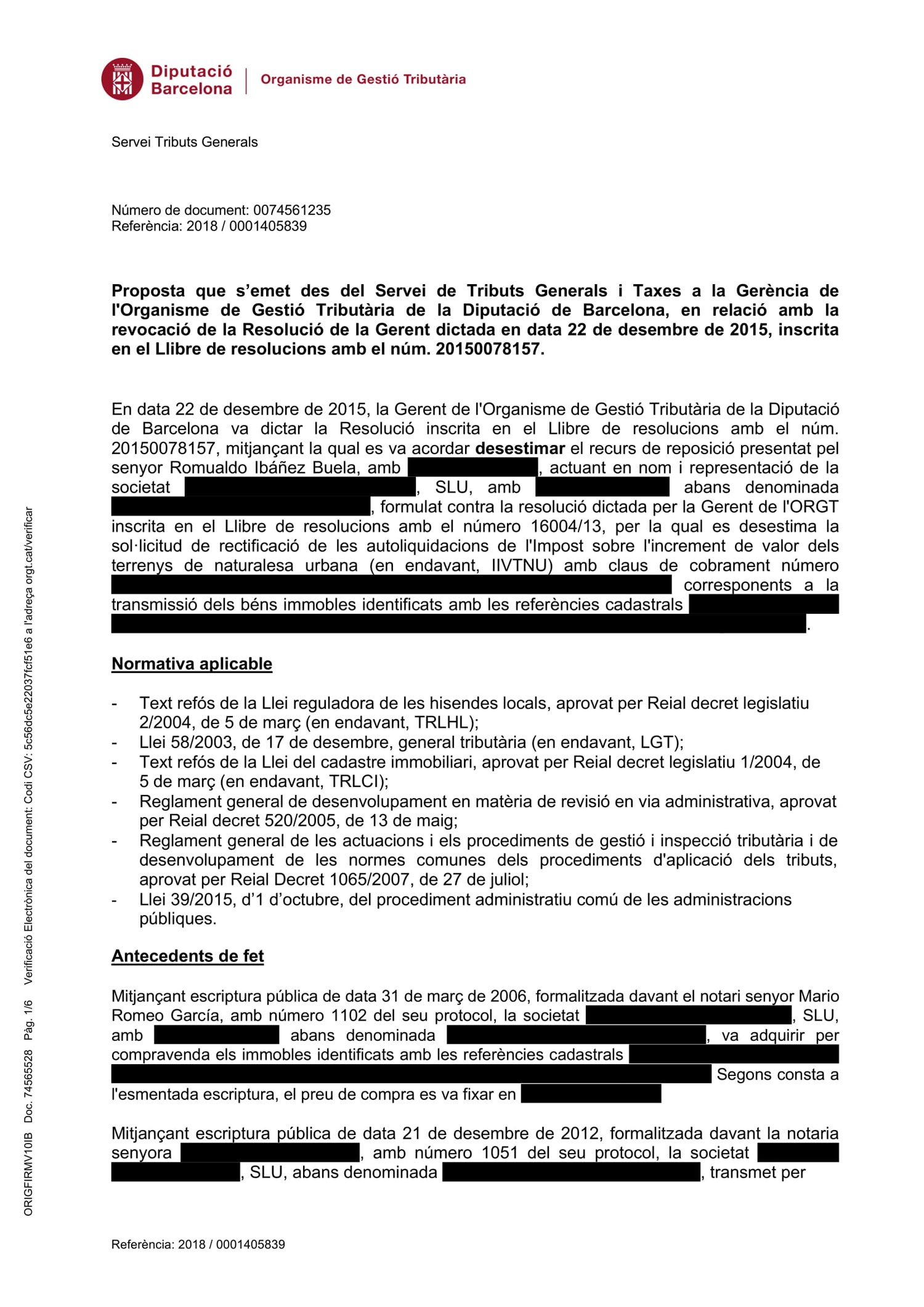Lo que vamos a explicar en este artículo no es ficción. Es un caso real de injusticia del sistema de administración tributaria español al calcular el impuesto de la plusvalía municipal en casos de venta de propiedades con pérdidas. Un sistema que carece de lógica y viola los derechos constitucionales de los contribuyentes. Para demostrar lo absurdo de la administración tributaria dirigida a la recaudación implacable de impuestos en la venta de propiedades, adjuntamos un documento administrativo de uno de nuestros casos. Hemos borrado los datos personales del cliente para proteger la seguridad y privacidad de sus datos.
Plusvalía Municipal- Uno de los impuestos inmobiliarios en España
En España existe un impuesto que recaudan los municipios. Todo el mundo lo conoce como “plusvalía municipal” (su nombre técnico es mucho más largo). Cuando alguien vende un inmueble, debe pagar un impuesto que depende del valor del terreno y según los años pasados. El impuesto se inventó pensando que el precio de los inmuebles siempre sube. Nadie pensó (¿increíble verdad?) que cuando alguien vende un inmueble también pueda perder dinero.
Todo eso cambió a partir de 2008. Muchos contribuyentes españoles y extranjeros vendían sus casas, pisos o terrenos por un precio menor del de compra. O sea, perdían dinero con la venta. Pero como la ley no lo decía expresamente, los ayuntamientos seguían exigiendo el impuesto. Es iba en contra de los derechos fundamentales de los contribuyentes, recogidos en la Constitución Española. La Constitución dice que sólo se deben pagar impuestos cuando se ha ganado dinero, cuando existe “riqueza”.
Pérdida de valor de la propiedad- ¿Se aplica la plusvalía municipal?
En este caso, lo lógico hubiera sido que la administración fiscal hubiera respetado los derechos fundamentales de los contribuyentes. La Constitución le obligaba a hacerlo. Pero, “lógicamente”, siguieron pidiendo el impuesto a personas y empresas que habían pedido dinero. Pronto los casos fueron miles. Algunos contribuyentes y sus abogados empezaron a oponerse. EXNOVO fue uno de ellos.
En el año 2012 un cliente de EXNOVO vendió unos terrenos con una fuerte pérdida económica, en una localidad cerca de Barcelona. A pesar de perder dinero, el ayuntamiento le exigió pagar 2.000 € en impuesto de “plusvalía municipal”. Le recomendamos pagar y después reclamar la devolución del impuesto. La devolución se pidió en 2012. La administración no contestó hasta 2015, negando la devolución. Tres años (3) para decir que no respetaba los derechos constitucionales de los contribuyentes.
El siguiente paso, en 2015, fue acudir a los tribunales de justicia. Se presentó la demanda, y el juzgado contencioso-administrativo (una división específica de los tribunales dedicada sólo a controlar a las administraciones públicas) fijó la fecha para el día 30 de octubre de 2018: tres (3) años después.
El día 29 de octubre de 2018 (1 día antes del juicio), la administración tributaria ha notificado a nuestro cliente que tiene razón y que le devuelven el dinero que pagó. Este es el documento que se adjunta. Seis (6) años después, se reconocen los derechos del contribuyente. Pero se le priva de la posibilidad de reclamar los gastos judiciales de seis (6) años de abogados e informes de expertos, ya que si no hay juicio, no puede haber obligación de pagar gastos judiciales.
Desgraciadamente, esta es la actitud que cualquier inversor debe esperar de la administración tributaria española, y estar preparado para afrontarla.
Enmiendas a la ley del impuesto de plusvalía municipal
En 2017 y 2018, el Tribunal Constitucional ha dictado sentencias que dicen que, si se vende la propiedad con pérdidas, el vendedor queda privado de la obligación de pagar el impuesto. Aquellos que sufrieron una pérdida debido a la venta de bienes inmuebles cuatro años antes de esa fecha todavía podrían reclamar un reembolso completo. En la actualidad está en proceso una modificación de la ley que recoja esa interpretación del Tribunal Constitucional.
¿Cualquiera puede solicitar una reclamación de devolución?
Desafortunadamente, el procedimiento no es tan sencillo y requiere la contratación de un abogado y peritos que preparen un informe de valor que pruebe la pérdida de valor. A veces, sin embargo, los costos de los servicios legales pueden superar el impuesto, por lo que es mejor hacer un cálculo breve antes de referir el asunto a abogados profesionales.
¿Cómo se calcula el impuesto plusvalía municipal?
Como he mencionado anteriormente, la plusvalía municipal se calcula con base en el valor catastral de la propiedad y los años de su posesión. Al hacer clic en este enlace pueden encontrar una calculadora que le ayudará a evaluar la cantidad de impuestos que se debe pagar. Por favor, recuerde que los resultados obtenidos no tienen valor legal y son solo para fines de orientación.
¿Es solo el vendedor quien puede pagar el impuesto de plusvalía municipal?
Dependiendo del acuerdo entre las partes, puede ser el vendedor o el comprador quien pague el impuesto de plusvalía municipal. Sin embargo, es recomendable que el proveedor asuma la responsabilidad total de la obligación de pago porque, si el comprador no lo hace, el proveedor tendrá que lidiar con las consecuencias. El pago debe realizarse dentro de los 30 días posteriores a una transacción exitosa.
Más información sobre plusvalía municipal, en el caso del Ayuntamiento de Barcelona, puede encontrarla en la página web del ayuntamiento.










